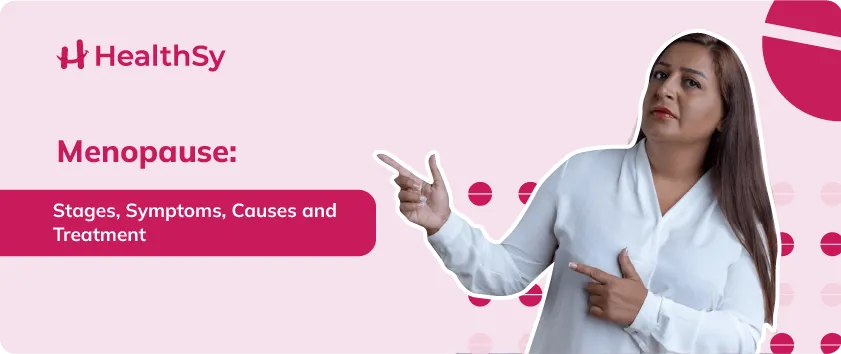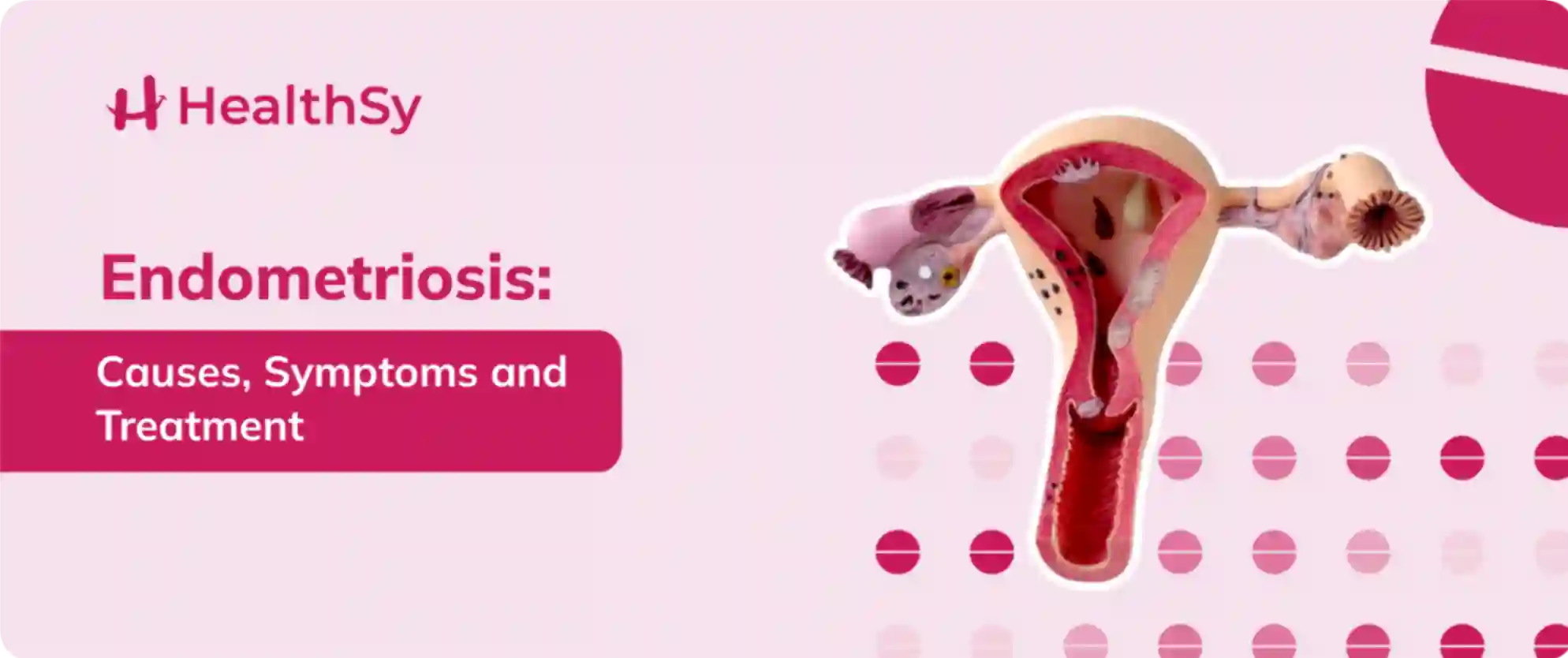Menopause: Stages, Symptoms, Causes and Treatment

Life is a series of chapters, each offering
its own set of hurdles and triumphs. For women, few chapters in their life are
as life changing as menopause – a natural biological process that signifies the
end of reproductive years. Understanding the complex journey of menopause is
not merely a matter of knowledge; it is an essential step towards educating and empowering patients. Menopause, a natural phase in a woman's life, brings a
plethora of changes that demand comprehensive awareness.
In addition, we acknowledge that each
woman's journey through menopause is distinct, influenced by genetics,
lifestyle, and the environment. This phase brings in an array of physical and
emotional changes that can be both fascinating and frustrating. Yet, with the
right understanding and support, going through menopause can be an enlightening
experience.
In this detailed blog, we shall delve
into the world of menopause. From the fundamental biology underlying the
process to the complexities of its stages, symptoms, causes, and treatments, we
will leave no stones unturned. Whether you are a woman preparing for this
transition, a partner seeking to understand and support you, or simply
inquisitive about the science behind the female body, this blog is designed to
provide you with the knowledge you seek.
What is Menopause?
The menopause occurs when a woman has gone
12 months without having a menstrual cycle. The term is sometimes used to
characterize the changes that occur just before or after menopause, which marks
the end of a woman's reproductive years. Typically, the menopause age for women
is around 50 years.
Menopause occurs when the ovaries stop
producing oestrogen and progesterone, two essential hormones needed for
fertility.
What are the Stages of Menopause?
Natural menopause is the permanent
cessation of menstruation that does not result from medical treatment. The
process occurs gradually and in three stages:
Perimenopause:
Perimenopause
begins eight to ten years before menopause when ovaries produce less oestrogen.
It usually starts in your 40s. Perimenopause lasts until menopause, which is
when your ovaries stop producing eggs. At this period, many women may
experience menopause symptoms. A few perimenopause symptoms include,
irregular periods, vaginal dryness, hot flashes, etc…
Menopause:
Menopause is the
period during which menstruation stops. At this point, your ovaries have
stopped releasing eggs and have stopped producing oestrogen.
Post menopause:
Post menopause is
the period that occurs after menopause, when a woman has not had a period for
an entire year or for life. Some women still have signs of menopause even after
the menopause transition.
Menopause Symptoms
The early symptoms of menopause include:
- Irregular periods
- Hot flashes and
night sweats
- Insomnia
- Mood swings and
emotional challenges
- Sore breasts
- Vaginal dryness
Other symptoms also include:
- Excessive weight
gain
- Experiencing
headaches
- Loss of hair
- Rapid heartbeat
- Changes in libido
- Depression
These symptoms are caused by shifts in hormone
levels. Some individuals may experience severe menopause symptoms, whereas
others may experience mild symptoms. During the transition to menopause, not
everyone will experience the same symptoms.
What is the Cause of Menopause?
Menopause is a natural process that
happens because of your levels of oestrogen, progesterone, and other hormones
change as you get older. Loss of active ovarian follicles is associated with
these changes. These hormones are responsible menstruation and fertility by
producing and releasing eggs from the ovarian wall.
In some instances, the menopause occurs
prematurely because of surgery, radiation therapy, chemotherapy, a pelvic
injury, or other factors influencing the reproductive organs, which is
referred to as induced menopause.
Diagnosis of Menopause
Menopause is typically diagnosed based on
a combination of clinical symptoms and menstrual cycle alterations. When a
woman has not had a menstrual period for 12 months in a row, menopause is
usually diagnosed. In some instances, however, the menopause may be diagnosed
earlier due to medical interventions, such as surgical removal of the ovaries
or specific medical treatments.
Doctors may also use blood tests to
measure hormone levels, such as Follicle-Stimulating Hormone (FSH) and
oestrogen, to help find out if a woman is going through menopause. A woman may
be in the perimenopausal or menopausal phase if her FSH levels are high and her
oestrogen levels are low.
Treatment Options for Menopause
Hormone Replacement Therapy (HRT):
Hormone Replacement
Therapy is a way to ease the effects of menopause by taking oestrogen and
sometimes progestin. It can alleviate hot flashes, vaginal dryness, and night
sweating effectively. However, HRT is not appropriate for all women,
particularly those with a history of certain diseases such as breast cancer. To
determine if HRT is an appropriate option, it is necessary to consult with a
healthcare professional.
Non-Hormonal Treatment:
The nonhormonal
treatments for menopause include nonhormonal medications, and lifestyle
modifications such as daily exercise, dietary habits, stress management, sleep
management, avoiding smoking, and limiting alcohol consumption.
If you are a woman preparing for menopause or experiencing the aforementioned symptoms and are unsure whether you are going through menopause, you can speak with a gynaecologist online.

Are you experiencing unusual changes in your body and wondering if you might be pregnant? Understanding early pregnancy symptoms can help you identify the signs and seek timely medical guidance. In today's digital age, getting expert advice is easier than ever through online gynaecologist consultations. In this blog, let us get to know the most common early pregnancy symptoms, and when to consult a gynaecologist online.
Common Early Pregnancy Symptoms to Watch
For
1. Missed Period
The most obvious sign of early pregnancy is a missed menstrual period. While this can have other causes, it is often the first indicator that prompts women to take a pregnancy test.
2. Morning Sickness
Despite its name, nausea and vomiting can occur at any time of day. This common early pregnancy symptom typically begins around the 6th week of pregnancy, though some women experience it earlier.
3. Breast Changes
Tenderness and swelling
Darkening of areolas
Noticeable veins on the breast surface
These changes often appear within weeks of conception due to hormonal fluctuations.
4. Fatigue
Feeling unusually tired? Early pregnancy can cause significant fatigue due to rising progesterone levels and increased blood production.
5. Frequent Urination
Even before your belly shows, you might notice increased bathroom visits. This early pregnancy symptom occurs due to hormonal changes and increased blood flow to the kidneys.
6. Food Aversions or Cravings
Sudden changes in food preferences or strong aversions to certain smells can be early indicators of pregnancy.
Less Common Early Pregnancy Symptoms
- Light spotting (implantation bleeding)
- Mild cramping
- Mood swings
- Bloating
- Headaches
- Constipation
When to Seek Medical Advice
While experiencing these symptoms doesn't automatically confirm pregnancy, it's essential to:
- Take a home pregnancy test
- Schedule a consultation with a healthcare provider
- Begin prenatal care early if pregnancy is confirmed
Benefits of Online Gynecologists
Consultation
Modern technology has made it easier than ever to connect with healthcare professionals. Online consultation with a gynaecologist offers several advantages:
- Convenience: Get expert advice from the comfort of your home
- Quick Access: No long waiting times for appointments
- Privacy: Discuss sensitive concerns discreetly
- Expert Guidance: Receive professional advice on managing early pregnancy symptoms
- Cost-Effective: Save on travel and consultation fees
How to Prepare for Your Online Doctor Consultation
Before your online consultation:
- Document your symptoms and their timeline
- Note any recent lifestyle changes
- Prepare questions about early pregnancy symptoms
- Have recent medical records handy
- Ensure good internet connectivity
Taking Care of Yourself
If you are experiencing early pregnancy symptoms, consider these self-care tips:
- Get adequate rest
- Stay hydrated
- Eat small, frequent meals
- Avoid known triggers for nausea
- Take prescribed prenatal vitamins
When to See a Doctor Immediately
Seek immediate medical attention if you experience:
- Severe abdominal pain
- Heavy bleeding
- Dizziness or fainting
- Severe headaches
- High fever
Conclusion
Early pregnancy symptoms can vary greatly among women, and not everyone experiences all signs. If you suspect you might be pregnant, do not hesitate to seek professional medical advice. Online consultations with a gynaecologist through HealthSy provide a convenient and efficient way to address your concerns and begin your pregnancy journey with proper guidance.
Remember, early prenatal care is crucial for both maternal and fetal health. Whether through traditional in-person visits or online consultations, reaching out to healthcare professionals when you notice early pregnancy symptoms is always the right choice.

Polycystic Ovary Syndrome (PCOS) is becoming increasingly prevalent among Indian women, particularly in younger age groups. While the exact cause remains elusive, hormonal imbalances appear to play a significant role. As we observe PCOS Awareness Month each September, it is clear that the number of women affected by this condition continues to rise.
Although medical treatments are available, many women are seeking natural alternatives to manage their PCOS symptoms. This growing interest in holistic approaches has led to a surge in home remedies and lifestyle modifications.
In this blog, we'll look into 10 simple yet powerful home remedies for PCOS. These natural solutions are easy to incorporate into your daily routine and may help alleviate symptoms while promoting overall well-being.
1. Apple Cider Vinegar
Apple cider vinegar is one of the most popular home remedies for PCOS. It may help:
- Reduce insulin resistance
- Promote weight loss
- Balance hormones
Try mixing 1-2 tablespoons of apple cider vinegar with water and drink it before meals.
2. Cinnamon
This common spice is not just for flavouring; it's also a powerful home remedy for PCOS. Cinnamon can:
- Improve insulin sensitivity
- Regulate menstrual cycles
- Reduce inflammation
Add a teaspoon of cinnamon to your daily diet through smoothies, oatmeal, or tea.
3. Spearmint Tea
Spearmint tea is a refreshing home remedy for PCOS that can:
- Lower androgen levels
- Improve hirsutism (excess hair growth)
- Regulate hormones
Enjoy 2-3 cups of spearmint tea daily for best results.
4. Flaxseeds
These tiny seeds pack a powerful punch as a home remedy for PCOS:
- Rich in omega-3 fatty acids
- High in lignans, which help balance hormones
- Support weight management
Incorporate 1-2 tablespoons of ground flaxseeds into your daily diet.
5. Turmeric
This golden spice is a staple in many home remedies for PCOS due to its:
- Anti-inflammatory properties
- Ability to improve insulin sensitivity
- Potential to reduce cyst formation
Add turmeric to your cooking or try a turmeric latte (golden milk) before bed.
6. Fenugreek
Fenugreek seeds are an ancient home remedy for PCOS that can:
- Improve insulin resistance
- Reduce inflammation
- Support healthy cholesterol levels
Soak 1 tablespoon of fenugreek seeds overnight and consume them in the morning.
7. Holy Basil (Tulsi)
Holy basil, or Tulsi, is a revered herb in Ayurvedic medicine and a potent home remedy for PCOS:
- Helps manage stress
- Balances hormones
- Improves insulin sensitivity
Brew holy basil tea or chew on fresh leaves daily.
8. Aloe Vera
Aloe vera is not just for skin care; it's also an effective home remedy for PCOS:
- Helps balance hormones
- Reduces inflammation
- Supports digestive health
Drink 1/4 cup of aloe vera juice daily or apply aloe gel topically for skin issues.
9. Evening Primrose Oil
This oil is rich in gamma-linolenic acid (GLA) and is a valuable home remedy for PCOS:
- May improve hormonal acne
- Can reduce breast pain and tenderness
- Supports overall hormonal balance
Take evening primrose oil supplements as directed by a healthcare provider.
10. Yoga and Meditation
While not a traditional "remedy," practicing yoga and meditation can significantly reduce stress, which is crucial for managing PCOS symptoms.
Remember, while these home remedies for PCOS can be effective, they should complement, not replace, professional medical advice. Always consult your gynaecologist before starting any new treatment regimen, especially if you're taking medications or have other health conditions.
By incorporating these simple and natural home remedies for PCOS into your lifestyle, you may find relief from symptoms and improved overall well-being. Give them a try and see which ones work best for you!

PCOD otherwise called as Polycystic Ovarian Disease, is an endocrinal disorder that commonly affects women in their reproductive years. The precise causes of PCOD are unknown but it can be triggered by poor lifestyle, obesity, stress, and so on. Following a balanced and thoughtful diet is one of many helpful approaches to managing this illness. Here, in this blog we will get to know in-detail about PCOD and PCOD Diet Plan for Weight Loss.
Is it crucial to have a PCOD diet plan for weight loss?
Yes, it is very crucial to have a PCOD diet plan for weight loss, particularly for those who have been diagnosed with this condition. The following are a few reasons why it is crucial:
- Insulin Resistance Management
- Hormonal Balance
- Improved Fertility
- Preventing Complications
- Weight Management
Which doctor should you see for PCOD, and when should you see a doctor?
Most people don't pay attention to the signs of PCOD, and some may not think it's a big deal. But it's very important to consult your doctor if you have any of the following symptoms:
Sudden weight gain particularly in the belly area
- Excessive bodily hair growth
- Oily skin and acne
- Irregular menstrual cycle
- Discomfort in pelvic area
- Trouble in getting pregnant
7-Days PCOD Diet Plan for Weight Loss
The recommended caloric intake range for women attempting to lose weight is 1200–1500 calories daily and it can vary based on the quantity and variety of food your intake. In general, this is a safe way to lose weight, and it can help you lose a substantial amount of weight. Below is a 7-day PCOD diet chart for weight loss. It can be modified based on your doctor’s or dietician’s suggestion. So, make sure to consult your doctor before making any dietary changes.
Sunday
- Breakfast: Idly 4Nos + ½ cup sambar / green chutney 1 tablespoon/tomato chutney (250-390Cal)
- Mid-Meal: 1 cup of sprouts, green gram (200-300Cal)
- Lunch: Roti 3Nos + ½ cup salad + fish curry (100gm fish) / cabbage subji (400-600Cal)
- Evening: 1 full portion of fruit (Calorie varies based on the fruit you eat)
- Dinner: Roti 2Nos / chapati + ½ cup tomato subji (190-280Cal)
Monday
- Breakfast: 2 Slice brown bread +1 slice low-fat cheese + 2 Boiled egg white(210-260Cal)
- Mid-meal: 1 full portion of fruit (Calorie vary based on the fruit you eat)
- Lunch: Veg pulao rice 1 cup+ 1/2 cup Soya Chunk curry+ 1/2 cup Butter Milk (330-490Cal)
- Evening: 1 cup light tea+ 2 wheat rusk (150-200Cal)
- Dinner: 2 roti/ Chapathi+ Ladies finger subji 1/2 cup (280-300Cal)
Tuesday
- Breakfast: Chapati 3 + 1/2 cup Potato green peas curry(400-450Cal)
- Mid-Meal: 1/2 cup boiled black channa (135-150Cal)
- Lunch: 1 cup rice+ 1/2 cup dhal + Palak subji 1/2 cup+ 1/2 cup low fat curd (420–490Cal)
- Evening: 1 full portion fruit (Calorie varies based on the fruit you eat)
- Dinner: Brocken wheat upma 1 cup+ 1/2 cup green beans subji (200-270Cal)
Wednesday
- Breakfast: Methi Parata 2+ 1 tbs green chutney (310-415Cal)
- Mid-meal: 1 full portion fruit (Calorie varies based on the fruit you eat)
- Lunch: 1 cup rice+ chicken curry (150 gm chicken) + 1 cup cucumber salad (515-570Cal)
- Evening: 1 Cup light tea+ Brown rice flakes poha 1 cup (210-240Cal)
- Dinner: Wheat dosa 3 + 1/2 cup Bitter guard subji (430-550Cal)
Thursday
- Breakfast: Vegetable Oats Upma 1 cup+ 1/2 cup low fat milk (190-250Cal)
- Mid-Meal: Plain Yoghurt with raw vegetables / grilled vegetables -1 cup (150-250Cal)
- Lunch: 1/2 cup rice + 2 medium chappati+1/2 cup Kidney beans curry+ Snake guard subji 1/2 cup (620-670Cal)
- Evening: 1 cup boiled channa+ light tea 1 cup (300-340Cal)
- Dinner: 2 Roti/ chapati+ 1/2 cup mix veg curry (280-320Cal)
Friday
- Breakfast: Mix veg Poha 1 cup+ 1/2 cup low fat milk
- Mid-Meal: 1 full portion fruit (Calorie varies based on the fruit you eat)
- Lunch: 3 Chappati+ 1/2 cup cluster beans subji+ Fish curry (100g fish) 1/2 cup
- Evening: 1 cup tea+ + 2 biscuits (Nutrichoice or Digestiva or Oatmeal) (150-200Cal)
- Dinner: 2 Roti / chapati + Ridge guard subji 1/2 cup (270-290Cal)
Saturday
- Breakfast: Uthappam 2+ 1 tbs green chutney (310-415Cal)
- Mid-Meal: 1 cup boiled channa (270-300Cal)
- Lunch: 1 cup rice+ Soya chunk curry1/2 cup+ Ladies finger subji 1/2 cup+ small cup low fat curd(460-550Cal)
- Evening: 1 full portion fruit (Calorie varies based on the fruit you eat)
- Dinner: Brocken wheat upma 1 cup+ 1/2 cup green beans subji (200-270Cal)
Note:
The calories could vary based on the food you eat along with the portions.
Pro Tips
- Increase daily water intake.
- Avoid overeating and consume balanced portions.
- Engage in regular physical exercises.
- Consume nutritious, unprocessed foods
Whom to Consult?
Consult a gynecologist if you are facing or suffering from any PCOD symptoms. You can also consult with specialists in hormone disorders (endocrinologists) or an infertility specialist (reproductive endocrinologists) for any related concerns.
Conclusion
Efficiently managing PCOD necessitates a well-organized diet plan. Hence, selecting the appropriate food and avoiding consuming those that will exacerbate the condition is crucial. Concentrate on the overall quality of life, hormone balance, and weight management. Additionally, scheduling routine check-ups with your physician is essential to better understanding your body.

When it comes to medical conditions, umbilical hernias may appear harmless at first, often disregarded as a simple bulge around the belly button. However, hiding beneath their seemingly harmless appearance lies the possibilities of severe complications if not addressed immediately. Proper conservative care or a surgical procedure based on the condition can help manage hernia. However, there are some complications that may arise and require urgent medical attention.
Let’s explore the frequently overlooked risks related to untreated umbilical hernias and highlight the importance of timely intervention.
The Hidden Complications of Umbilical Hernia
Umbilical hernias, though common, are not to be taken lightly. Here's why:
Bowel Obstruction
The intestines may get compressed as the hernia grows, causing a risk to life and causing intestinal obstruction. This obstruction requires immediate medical attention when it causes severe discomfort, vomiting, and constipation.
Strangulation
Strangulation, a terrible consequence of untreated umbilical hernias, occurs when the blood supply to the extending intestine is stopped. This critical condition can lead to necrosis, or tissue death, and requires prompt surgical intervention to avoid life-threatening outcomes.
Incarceration
The hernia sac may occasionally become detained, so it gets stuck outside the abdominal wall. If this is not treated right away, it may result in severe pain, swelling, and even tissue damage.
Complications in Infants and Children
Although infant umbilical hernias frequently heal on their own, if left untreated, they can cause developmental delays and increase a kid's tendency to more serious issues in the future. Untreated hernias in children increase the danger of intestinal blockage and strangulation, as well as the possibility of ongoing discomfort.
Umbilical Hernia:
If you fear an umbilical hernia or experience any alarming signs, you should act quickly
Seek Medical Attention: If you think you may have an umbilical hernia, get a comprehensive evaluation by seeing a medical practitioner right away. Early diagnosis lowers the chance of problems and enables prompt action.
Look into Surgical Interventions: A surgical intervention is frequently required, especially if the hernia is symptomatic or presents a risk of complications, some umbilical hernias may heal on their own. To decide on the best course of action, consult your general physician or general surgeon about your treatment options.
Sustain a Healthy Lifestyle: Although changes in one's lifestyle cannot heal an umbilical hernia that already exists, they can slow its spread and lower the chance of adverse effects. Keep your weight in check, refrain from excessive lifting, and take care of your posture to reduce the tension in your abdominal muscles.
Remain Alert: Observe any modifications to your umbilical hernia's size, shape, or symptoms. Visit your doctor right once if you experience any new or worsening symptoms.
Wrapping Up
Umbilical hernias may seem inconsequential, but the risks of leaving them untreated are too significant to ignore. The possible problems are serious and require immediate attention, ranging from tissue strangulation to intestinal blockages. You may protect your health and well-being from the silent threat of untreated umbilical hernias by getting medical attention as soon as possible and thinking about the right interventions. Keep in mind that your health is too valuable to take chances with; take immediate action and put your well-being first.

Endometriosis is a debilitating condition that affects thousands of
women every year, disrupting their lives with excruciating pain and often
causing infertility. For those affected, mere period cramps can escalate into
unbearable agony. However, amidst the distress, there is hope. By seeking
guidance from experts and exploring treatment options, women can reclaim
control over their lives and find relief from the suffocating grip of
endometriosis.
What is Endometriosis?
Endometriosis, a painful condition, occurs when tissue like the uterus
lining grows outside the uterus, often affecting ovaries, fallopian tubes, and
pelvic lining. This tissue behaves like uterine lining, thickening, breaking
down, and bleeding during menstrual cycles, leading to complications such as
cysts (endometriomas), irritation, scar tissue, and adhesions.
Symptoms of Endometriosis
Pelvic pain is the primary symptom of endometriosis. It is usually
linked with menstrual cycles. People with endometriosis often experience more
severe menstrual cramps compared to others.
The common symptoms of endometriosis include:
- Painful Periods: The symptoms normally
involve intense cramping, discomfort in the lower back, and heavy bleeding.
These symptoms can have a major impact on daily activities and overall quality
of life for individuals.
- Sexual Discomfort:
Experiencing pain during or after
sex is a common occurrence for individuals with endometriosis. This condition
may require medical intervention to manage symptoms effectively.
- Constipation or
Urination Pain: These symptoms are commonly
experienced before or during a menstrual period.
- Heavy Bleeding: Sometimes, individuals can experience excessive
menstrual bleeding or bleeding that happens beyond their regular period.
- Infertility: For some people, endometriosis can be found during
infertility treatment tests.
The Cause of Endometriosis
The exact cause of endometriosis is unclear. However, according to
experts, there may be a connection with:
- Retrograde Menstruation: Menstrual blood flows backward into the pelvis,
carrying endometrial cells that stick to pelvic organs and grow.
- Transformed Peritoneal
Cells: Hormones or immune factors may
change abdominal lining cells into endometrial-like cells.
- Embryonic Cell
Changes: Hormones like estrogen can turn
early-stage cells into endometrial-like growths during puberty.
- Surgical Scar
Complications: Endometrial cells may attach
to scars from surgeries like C-sections.
- Endometrial Cell Transport: Blood vessels or fluid systems may carry endometrial
cells to other parts of the body.
- Immune System
Issues: Problems with the immune system
may prevent it from recognizing and destroying endometriosis tissue.
Addressing Endometriosis
A detailed history of menstrual symptoms and pelvic pain helps to
suspect endometriosis. While various screening tools exist, none reliably finds
those likely to have the disease. Endometriosis symptoms can resemble other
conditions, leading to delays in diagnosis. Ultrasound or MRI may be needed to
detect certain forms of the disease. Surgical visualization followed by
histologic confirmation is often necessary for diagnosis, especially for
superficial lesions.
Treatment options for endometriosis
There are different treatment options available for endometriosis, which
depend on the severity of symptoms, desire for fertility, and overall health.
Here are some common methods:
1. Pain Medications
There are over-the-counter pain relievers available that can provide
relief from menstrual cramps and pelvic pain.
2. Hormonal Therapies
- Birth Control
Pills: Hormonal contraceptives could regulate menstrual cycles and alleviate
the intensity of symptoms.
- Gonadotropin-Releasing
Hormone (GnRH) Agonists and Antagonists: These medications work by suppressing
ovarian hormone production, which leads to a temporary state like menopause.
This can help alleviate symptoms.
- Progestin Therapy:
Progestin-only medications, such as Depo-Provera injections or the hormonal
IUD, can help reduce menstrual flow and pain.
3. Surgery
- Laparoscopic
Surgery: Surgery to remove endometrial tissue and adhesions can offer relief
and potentially enhance fertility through minimally invasive techniques.
- Hysterectomy: When
all other treatments have proven ineffective, and fertility is undesirable,
surgical excision of the uterus and potentially the ovaries may be advised as a
last resort.
4. Fertility Treatment
Individuals who are experiencing infertility because of endometriosis
may wish to contemplate the use of aided reproductive technologies, including
in vitro fertilization (IVF).
It is crucial for individuals with endometriosis to work closely with gynecologists to develop a tailored treatment plan that considers their
specific needs and goals. Through collaboration, patients can ensure their
symptoms are managed and they receive the most suitable care. This can lead to
improved quality of life and better overall health outcomes for those living
with endometriosis.

Post A Comment